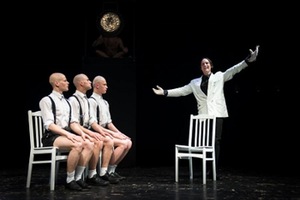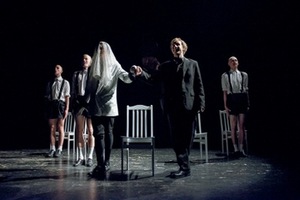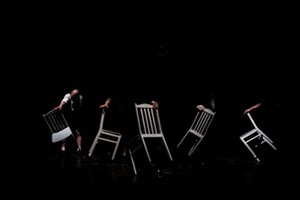Behind the door of “The Dream” – new generation of theatre creators 3
In brief: The premiere of the performance “The Dream” created by the young theatre creators’ generation on the motifs of the play of A.Strindberg was presented at the Lithuanian National Drama Theatre on September 22. The performance directed by Kamilė Gudmonaitė featured 3rd year students of direction course of the Lithuanian Academy of Music and Theatre supervised by Doc. Gintaras Varnas.
K. Gudmonaitė has chosen two scenes for the performance ”Opening of the door” and ”Lesson”. The collage structure of A. Strindberg’s play “The Dream” (1902) presupposes the possibility of deconstruction. The chosen extracts of the work are composed by ruining the sequence presented in the text and reveal the thematic analogy of these scenes.
When one thinks about the performance, the wish appears to draw concentric circles and imagine the planetary model of the atom structure of E. Rutherford. The play of A. Strindberg and the performance directed by K. Gudmonaitė are like the Baroque allegorical mystery play “The Great Theatre of the World” of P. Calderon which encompasses the aggregate model of the world in which God is one of the characters. Although the performance “The Dream” was created from two scenes of the play, the aggregate view of the world encoded in A. Strindberg’s work is revealed. Therefore, when contemplating the performance, we could place the man in one concentric circle, social environment in another and God analysing the relations between the former two – in the third circle.
During the performance the spectator is invited to dip into the real play of theatre magic. The composition of the performance, rhythm, astounding harmony among actors on the stage create the special magnetic field to which the viewer is involved and is able to experience the real catharsis possible in the theatre art only. The stylistic unity of the performance and the harmony of the composition create aesthetic pleasure: the harmonious beauty of the structure is moving.
Thus, the author concludes that the philosophical performance of K. Gudmonaitė “The Dream” and the work of Povilas Makauskas “YOLO” is the evident proof that a new chapter starts in the history of Lithuanian theatre called “the new talented generation of directors has stepped to the theatre stage.”





